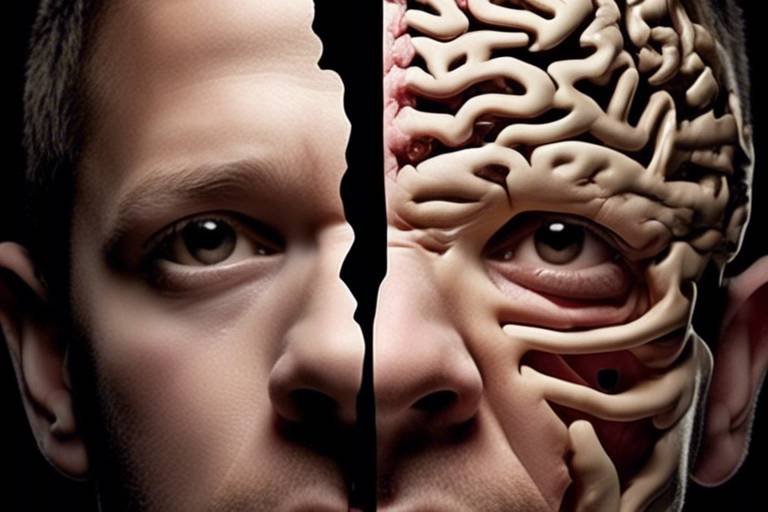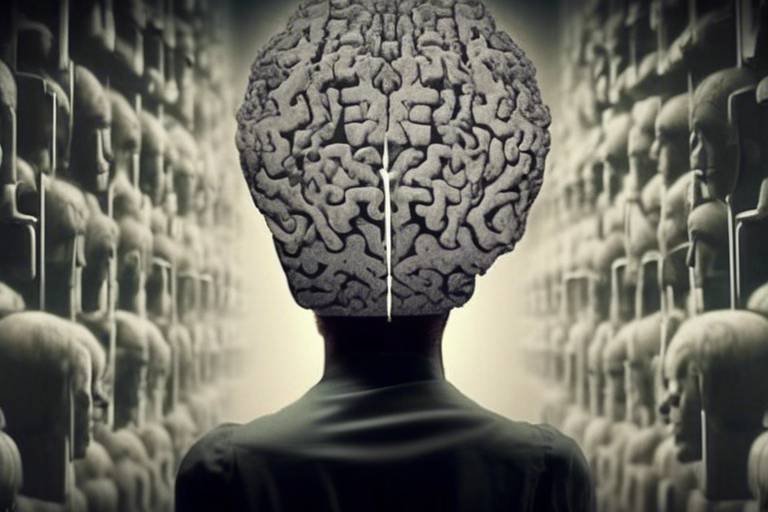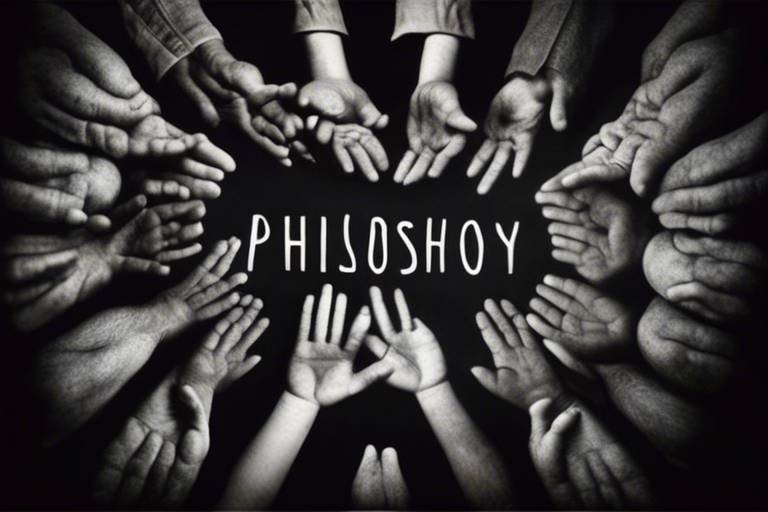The Puzzle of Perceptual Consciousness
Perceptual consciousness is like a fascinating puzzle, one that invites us to explore the depths of human experience and cognition. Have you ever wondered how you can be aware of your surroundings, yet sometimes miss the details? This intricate tapestry of awareness is woven from countless threads, each representing different aspects of perception. In this article, we will embark on a journey to unravel the complexities of perceptual consciousness, examining its mechanisms, the theories that attempt to explain it, and the implications it holds for our understanding of what it means to be conscious.
So, what exactly is perceptual consciousness? At its core, it refers to our ability to experience and be aware of our sensory perceptions. Imagine walking through a vibrant forest; the rustling leaves, the chirping birds, and the earthy scent of the ground all contribute to your conscious experience. This section will delve deeper into the definition of perceptual consciousness, its defining characteristics, and the pivotal role it plays in shaping our daily interactions with the world around us.
Perceptual consciousness can be characterized by several key features: it is subjective, dynamic, and multi-faceted. Subjectivity means that each individual's perception is unique, influenced by personal experiences and context. The dynamic nature of consciousness indicates that it is constantly changing; one moment you might be fully immersed in a conversation, while the next, your mind wanders to distant thoughts. Finally, the multi-faceted aspect of consciousness suggests that it encompasses a variety of sensory modalities, from sight and sound to taste and touch.
As we venture further into the realm of perceptual consciousness, we encounter various theories that seek to explain this enigmatic phenomenon. These theories provide frameworks for understanding how consciousness arises and operates. Among the most prominent are the Integrated Information Theory (IIT) and the Global Workspace Theory (GWT). Each theory offers unique insights that contribute to our overall understanding of perceptual consciousness.
Integrated Information Theory (IIT) posits that consciousness is fundamentally linked to the level of information integration within a system. Think of it as a symphony where each instrument contributes to a harmonious whole. The more integrated the information, the richer the conscious experience. In this section, we will explore the implications of IIT for our understanding of perceptual experiences and the nature of awareness.
At the heart of IIT are several key principles that help elucidate its core concepts:
- Information: This refers to the variety and complexity of the data being processed.
- Integration: This principle emphasizes the interconnectedness of information; consciousness arises when information is unified rather than fragmented.
- Phi Value: This quantifies the degree of consciousness by measuring how much information is integrated within a system.
While IIT provides valuable insights into the nature of consciousness, it is not without its critiques. Some argue that the theory lacks empirical support and that the phi value may not accurately reflect the richness of conscious experience. This section will discuss these limitations and challenges, offering a balanced view of IIT's applicability in the scientific community.
Global Workspace Theory (GWT) presents a different perspective, suggesting that consciousness emerges from the broadcasting of information across various cognitive processes. Imagine a stage where different performers (cognitive processes) present their acts to an audience (consciousness). This subsection will examine how GWT explains perceptual consciousness and the mechanisms involved in this broadcasting process.
Attention is a critical player in the game of perceptual consciousness. It acts like a spotlight, illuminating certain aspects of our environment while leaving others in the shadows. This section investigates how selective attention influences what we perceive and how our conscious experiences are formed. Without attention, our consciousness would be overwhelmed by the sheer volume of sensory information flooding in.
Understanding the mechanisms of attention is key to clarifying its impact on consciousness. There are various types of attention, including focused attention, sustained attention, and divided attention. Each type plays a unique role in shaping our perceptual awareness and can significantly influence our conscious experiences.
The relationship between attention and perception is intricate and profound. Attentional focus can enhance our perceptual experiences, allowing us to savor the details of a beautiful sunset or the intricate flavors of a gourmet meal. Conversely, when our attention is divided or misdirected, we may overlook important details, leading to a skewed perception of reality. This part will explore how attentional dynamics shape our conscious awareness and influence our interactions with the world.
- What is perceptual consciousness? Perceptual consciousness refers to our awareness of sensory perceptions and experiences.
- How does attention affect consciousness? Attention acts as a filter, determining what sensory information reaches our conscious awareness.
- What are the main theories of consciousness? Two prominent theories are the Integrated Information Theory (IIT) and the Global Workspace Theory (GWT).
- What is the phi value in IIT? The phi value quantifies the degree of consciousness based on the level of information integration.

The Nature of Perceptual Consciousness
Understanding what perceptual consciousness entails is crucial in grasping how we interact with the world around us. At its core, perceptual consciousness refers to the awareness we have of our sensory experiences. It's that moment when you feel the warmth of the sun on your skin or hear the gentle rustle of leaves in the breeze. But what exactly does it mean to be perceptually conscious? It’s more than just a passive experience; it’s an active engagement with our environment that shapes our thoughts, emotions, and actions.
One of the most fascinating aspects of perceptual consciousness is its dynamic nature. It’s not a static state but rather a fluid process that changes based on various factors, including attention, context, and even our previous experiences. Imagine walking through a bustling market. Your perceptual consciousness is constantly shifting as you navigate through the sights, sounds, and smells. One moment, you might be captivated by the vibrant colors of fresh produce, and the next, your attention might be drawn to the laughter of children playing nearby. This constant flux illustrates how perceptual consciousness is intricately linked to our attentional focus.
Moreover, perceptual consciousness serves several critical functions in our daily lives. It allows us to:
- Interpret sensory information: We make sense of the world by integrating various sensory inputs, creating a cohesive experience.
- Guide behavior: Our conscious awareness informs our decisions and actions, helping us navigate complex environments.
- Facilitate social interactions: Understanding others' emotional states often relies on our perceptual consciousness, as we read facial expressions and body language.
In essence, perceptual consciousness is a tapestry woven from our sensory inputs, cognitive processes, and emotional responses. It’s the lens through which we view and interact with the world, shaping our experiences and influencing how we perceive reality. As we delve deeper into the intricacies of this fascinating phenomenon, we begin to unravel the complexities of human cognition and the profound implications it holds for our understanding of consciousness itself.

Theories of Consciousness
When we dive into the fascinating world of consciousness, we quickly realize that it's not just a single entity but a complex tapestry woven from various theories and ideas. Each theory attempts to unravel the enigma of how we experience the world around us, shedding light on the intricate mechanisms that make up our perceptual consciousness. Among the most prominent theories are the Integrated Information Theory (IIT) and the Global Workspace Theory (GWT). These frameworks provide unique lenses through which we can view consciousness, offering insights that are as enlightening as they are thought-provoking.
The Integrated Information Theory posits that consciousness is fundamentally linked to the integration of information. In simpler terms, the more interconnected and unified the information we process, the richer our conscious experience becomes. This theory suggests that consciousness can be quantified using a measure called the phi value, which indicates the degree of integration within a system. If you think about it, this is akin to a symphony orchestra where each instrument must harmonize with the others to create a beautiful piece of music. If one instrument is out of sync, the entire performance can falter. Similarly, our conscious experience is enhanced when information flows seamlessly and cohesively.
On the other hand, the Global Workspace Theory presents a different perspective. It suggests that consciousness arises from a ‘global workspace’ in the brain where information is broadcasted to various cognitive processes. Imagine a stage where different performers (or cognitive processes) come together to create a show. Only the information that is ‘on stage’—or in the global workspace—becomes part of our conscious awareness. This theory emphasizes the role of attention in determining what information gets to be highlighted and what fades into the background. It’s like a spotlight that shines on certain performers while others remain in the shadows, waiting for their moment to shine.
Both theories offer compelling insights, but they also come with their own sets of critiques and challenges. For instance, while IIT provides a robust framework for understanding the complexity of consciousness, some argue that it may be too abstract and lacks empirical support in certain areas. Conversely, while GWT effectively explains the role of attention, critics point out that it may not fully account for the subjective quality of experiences that we often associate with consciousness.
In summary, the exploration of consciousness is like piecing together a jigsaw puzzle where each theory represents a unique piece. By examining these theories, we not only gain a deeper understanding of how consciousness operates but also appreciate the rich tapestry of human experience. As we continue to explore these ideas, we are reminded that consciousness is not just a scientific inquiry but a profound aspect of what it means to be human.

The Integrated Information Theory
The Integrated Information Theory (IIT), proposed by neuroscientist Giulio Tononi, presents a fascinating approach to understanding consciousness. At its core, IIT suggests that consciousness is not just a byproduct of brain activity but is intricately tied to the way information is processed and integrated within the brain. Imagine your brain as a symphony orchestra, where each instrument represents a different piece of information. For a beautiful melody to emerge, these instruments must not only play their notes but also harmonize with one another. Similarly, in IIT, consciousness arises when information is integrated in a unified manner, leading to a rich and coherent experience.
One of the key concepts of IIT is the idea of phi (Φ), a measure of the degree of consciousness. The higher the phi value, the more integrated the information is, and thus, the richer the conscious experience. Think of it as a light bulb: a low phi value corresponds to a dim light, where the components are not well integrated, while a high phi value represents a bright light, illuminating a vibrant and complex experience. This framework allows us to quantify consciousness and offers a novel way to assess different states of awareness, whether in humans or even in artificial systems.
However, IIT does not merely stop at quantifying consciousness; it also provides a profound insight into the nature of awareness itself. It suggests that consciousness is fundamentally about the connections and relationships between different elements of information. This perspective shifts the focus from isolated brain processes to the network of interactions that give rise to our subjective experiences. For instance, when you see a beautiful sunset, your experience is not just about the colors and shapes; it's about how your brain integrates all that sensory information, memories, and emotional responses into a cohesive experience.
Despite its intriguing propositions, IIT is not without its challenges. Critics argue that while it offers a compelling framework, it may oversimplify the complexities of consciousness. Some researchers point out that measuring phi can be difficult and that more empirical evidence is needed to validate the theory fully. Additionally, the application of IIT to non-human consciousness remains a contentious topic. Nevertheless, IIT has sparked valuable discussions and research, pushing the boundaries of how we think about consciousness.
In summary, the Integrated Information Theory provides a unique lens through which we can explore the intricate tapestry of perceptual consciousness. By emphasizing the role of information integration and offering a quantifiable measure of consciousness, IIT paves the way for deeper understanding and further inquiry into the mysteries of the mind.

Key Principles of IIT
The Integrated Information Theory (IIT) is a fascinating framework that attempts to unravel the complex web of consciousness. At its core, IIT posits that consciousness is not merely a byproduct of brain activity but rather a fundamental aspect of how information is processed. One of the key principles of IIT is the concept of information, which refers to the richness and variety of data that the brain can integrate. Think of it as a tapestry woven from countless threads of sensory experiences; the more intricate the weave, the more profound the consciousness.
Another crucial aspect of IIT is integration. This principle suggests that consciousness arises when information from various sources is combined into a unified experience. Imagine trying to solve a jigsaw puzzle: each piece represents a fragment of information, and only when they are interlocked do you see the complete picture. In this way, the brain integrates sensory inputs, thoughts, and emotions to create a coherent conscious experience.
Central to understanding IIT is the phi value, a quantitative measure of consciousness. The phi value quantifies the degree of information integration within a system. A higher phi value indicates a greater level of consciousness, suggesting that a system is more aware of its own state and capable of processing complex information. For instance, consider two systems: one is a simple light switch (low phi), and the other is a human brain (high phi). The difference in their phi values illustrates the vast disparity in their conscious experiences.
In summary, the key principles of Integrated Information Theory revolve around the ideas of information richness, integration of diverse inputs, and the quantification of consciousness through the phi value. Together, these principles provide a compelling lens through which we can explore the depths of perceptual consciousness, revealing the intricate dance of awareness that defines our human experience.

Critiques of IIT
While Integrated Information Theory (IIT) has garnered attention and sparked fascinating discussions in the realm of consciousness studies, it is not without its critics. Many researchers and philosophers have raised concerns regarding the theory's assumptions and implications. One significant critique is the theory's reliance on the concept of information integration as the sole determinant of consciousness. Critics argue that this perspective may be overly simplistic, as it does not account for the qualitative aspects of conscious experience, often referred to as qualia.
Moreover, the quantification of consciousness through the phi value has also been challenged. The phi value is intended to measure the degree of integrated information within a system, yet skeptics question whether it can truly capture the richness and complexity of conscious experiences. For instance, can we really reduce our rich tapestry of experiences—like the joy of a sunset or the taste of chocolate—to a mere numerical value? This reductionist approach is seen by some as a significant limitation.
Another point of contention is the applicability of IIT across different types of systems. Critics argue that the theory primarily focuses on biological consciousness and may not adequately address the consciousness of artificial systems, which are becoming increasingly relevant in today's technological landscape. This raises questions about whether IIT can be universally applied or if it is inherently biased towards human experiences.
Additionally, some researchers have pointed out that IIT lacks empirical support. While it presents a compelling theoretical framework, the challenge remains in validating its claims through experimental data. The absence of concrete evidence leaves room for skepticism, as the scientific community often relies on robust data to support theoretical propositions.
In summary, while IIT provides intriguing insights into the nature of consciousness, it is essential to approach the theory with a critical eye. The critiques highlight the complexity of consciousness and remind us that our understanding is still evolving. As the debate continues, it is clear that a multi-faceted approach will be necessary to unravel the intricate puzzle of perceptual consciousness.
- What is Integrated Information Theory?
Integrated Information Theory (IIT) is a theoretical framework that suggests consciousness corresponds to the level of information integration within a system.
- What are the main critiques of IIT?
Main critiques include its reliance on information integration as the sole determinant of consciousness, challenges to the phi value's effectiveness, and the lack of empirical support.
- Can IIT be applied to artificial systems?
Critics argue that IIT primarily focuses on biological consciousness and may not adequately address the consciousness of artificial systems.
- How does IIT relate to qualitative experiences?
Some argue that IIT's reductionist approach may overlook the qualitative aspects of conscious experiences known as qualia.

The Global Workspace Theory
The Global Workspace Theory (GWT) presents a fascinating perspective on how consciousness operates within our minds. Imagine your brain as a vast theater, where various cognitive processes act like actors on a stage. In this metaphor, the global workspace serves as the spotlight, illuminating specific pieces of information while relegating others to the shadows. This theory suggests that consciousness arises when information is broadcasted to a wide array of cognitive systems, allowing us to become aware of certain thoughts and experiences while others remain unconscious.
At its core, GWT posits that our conscious experience is not a singular entity but rather a dynamic interplay of information processing. When an event occurs—let's say you see a beautiful sunset—various sensory inputs are processed simultaneously. However, only the most salient or relevant information gets the spotlight, which then influences your thoughts, decisions, and actions. This selective broadcasting is crucial; it enables us to navigate through the complexities of life without being overwhelmed by every minute detail.
One of the most intriguing aspects of GWT is its implication for understanding how we prioritize information. For instance, when you’re engrossed in a conversation at a noisy party, your brain filters out background chatter, allowing you to focus on the dialogue in front of you. This ability to select and amplify certain stimuli while disregarding others is essential for effective functioning in our daily lives.
To further illustrate the principles of GWT, consider the following key components:
- Information Broadcasting: The theory emphasizes that consciousness is not just about being aware of something; it’s about broadcasting that awareness to other cognitive processes. This broadcasting allows for integration and coordination of thoughts and actions.
- Competition for Attention: Different pieces of information vie for the spotlight in our global workspace. The most relevant or urgent information typically wins this competition, influencing our conscious experience.
- Access and Reportability: According to GWT, only the information that has been successfully broadcasted can be reported or acted upon. This means that much of our cognitive processing happens outside of our conscious awareness.
In summary, the Global Workspace Theory offers a compelling framework for understanding how consciousness emerges from the interactions of various cognitive processes. It highlights the importance of attention and selective information processing in shaping our conscious experiences. By viewing consciousness as a dynamic theater of competing information, we can appreciate the complexity of our mental lives and the intricate mechanisms that govern our awareness.
Q: What is the Global Workspace Theory?
A: The Global Workspace Theory posits that consciousness arises from the broadcasting of information across various cognitive processes, allowing us to become aware of certain thoughts and experiences.
Q: How does attention relate to the Global Workspace Theory?
A: Attention plays a critical role in GWT as it determines which pieces of information are selected for broadcasting to our conscious awareness, influencing our perception and decision-making.
Q: Can unconscious processes influence conscious experience?
A: Yes! According to GWT, many cognitive processes occur outside of our conscious awareness, but they can still influence our thoughts and actions once they are brought into the global workspace.

The Role of Attention
Attention is like the spotlight on a stage, illuminating certain aspects of our experience while leaving others in the shadows. It’s a crucial player in the theater of our minds, shaping what we perceive and how we interact with the world around us. Without attention, our consciousness would be a chaotic jumble of sensory information, making it nearly impossible to navigate through daily life. But how does this spotlight work, and why is it so significant in the realm of perceptual consciousness?
To understand the role of attention, we first need to recognize that it is not a monolithic entity. Instead, it comprises various mechanisms that work in tandem to filter and prioritize information. These mechanisms include selective attention, which allows us to focus on specific stimuli while ignoring others, and divided attention, which enables us to manage multiple tasks at once. Think of it as a multi-tasking chef in a bustling kitchen, expertly juggling several pots on the stove while still keeping an eye on the oven timer.
Selective attention is particularly fascinating because it determines what enters our conscious awareness. For instance, when you’re at a noisy party, you might find it challenging to hear the person next to you speaking. Your brain actively filters out the background noise, allowing you to concentrate on that one voice. This ability to hone in on relevant information is essential for effective communication and interaction, making it a cornerstone of our social experiences.
Moreover, attention can significantly influence our perception of reality. When we focus our attention on a particular object or event, we tend to perceive it more vividly and accurately. Conversely, if our attention is divided, our perception may become muddled or incomplete. This interplay between attention and perception highlights the dynamic nature of consciousness, which is constantly shaped by what we choose to focus on.
To illustrate this relationship, consider the following table that summarizes how different types of attention affect our perceptual experiences:
| Type of Attention | Effect on Perception |
|---|---|
| Selectively Focused Attention | Enhances clarity and detail of the chosen stimulus |
| Divided Attention | Reduces accuracy and detail in perception |
| Vigilant Attention | Increases awareness of changes in the environment |
Attention also plays a pivotal role in memory formation. When we pay attention to something, we are more likely to encode that information into our memory. This is why you might remember a captivating lecture but struggle to recall details from a mundane meeting. The quality of our attention can either enhance or inhibit our ability to learn and retain information, further emphasizing its importance in our cognitive processes.
In conclusion, attention is not just a passive process; it actively shapes our conscious experience and perception of the world. By directing our focus, we can navigate through the complexities of life, enhancing our understanding and interaction with our surroundings. So, the next time you find yourself lost in thought or distracted by noise, remember that your attention is the key to unlocking a richer, more vibrant experience of reality.
- What is the difference between selective and divided attention? Selective attention involves focusing on a specific stimulus while ignoring others, whereas divided attention refers to managing multiple tasks simultaneously.
- How does attention affect memory? Attention enhances memory formation by ensuring that relevant information is encoded more effectively.
- Can attention be trained? Yes, various techniques, such as mindfulness and meditation, can help improve attention and focus.

Mechanisms of Attention
Attention is like a spotlight in a dark theater, illuminating only certain parts of the stage while leaving the rest in shadow. This mechanism is fundamental to how we experience the world around us, as it determines what we focus on and what slips into the background. Essentially, attention acts as a filter, allowing us to prioritize information that is most relevant to our goals and needs. But how does this intricate process work? Let's dive into the various mechanisms that govern attention and how they shape our perceptual consciousness.
One of the primary mechanisms of attention is the distinction between selective attention and divided attention. Selective attention allows us to focus on a specific stimulus while ignoring others, much like tuning into a single conversation at a bustling party. On the other hand, divided attention enables us to process multiple sources of information simultaneously, although this often comes at a cost to performance. Imagine trying to cook dinner while watching a movie; you might miss crucial plot points or burn the food!
Additionally, attention can be categorized into two types: top-down attention and bottom-up attention. Top-down attention is driven by our goals, expectations, and prior knowledge. For instance, if you’re looking for a friend in a crowd, your brain actively seeks out familiar features, filtering out irrelevant faces. Conversely, bottom-up attention is more reflexive, responding to salient stimuli in our environment, such as a loud noise or a sudden movement. This type of attention is akin to a moth drawn to a flame, where our senses are captivated by something unexpected.
Understanding these mechanisms is crucial for grasping how attention influences our perception. When we concentrate on a particular task, like reading a book, our brain suppresses distractions, allowing us to absorb information deeply. However, if something grabs our attention unexpectedly, like a phone notification, it can disrupt our focus, leading to a phenomenon known as the attentional blink. This occurs when we struggle to process a second stimulus that appears soon after the first, akin to trying to catch two balls thrown at you in quick succession—often, you only manage to catch one!
Moreover, the neurobiological underpinnings of attention involve various brain regions, including the prefrontal cortex, which is crucial for executive functions, and the parietal lobe, which helps orient our attention in space. These areas work in harmony, ensuring that we can navigate our environment efficiently. For instance, when you’re driving, your prefrontal cortex helps you make decisions about when to change lanes, while your parietal lobe keeps track of other vehicles around you.
In summary, the mechanisms of attention are complex and multifaceted, playing a vital role in shaping our conscious experiences. By understanding how selective and divided attention work, alongside the influence of top-down and bottom-up processes, we can appreciate the intricate dance of perception and awareness. It’s like being the conductor of an orchestra, where attention directs the symphony of our sensory experiences, ensuring that the most important notes are heard clearly amidst the chaos of everyday life.
- What is the difference between selective and divided attention? Selective attention focuses on one specific stimulus while ignoring others, whereas divided attention processes multiple stimuli at once.
- How do top-down and bottom-up attention differ? Top-down attention is driven by goals and expectations, while bottom-up attention responds to external stimuli that capture our interest.
- Why is attention important for perception? Attention filters out distractions and enhances our ability to process relevant information, shaping our conscious awareness of the world.

Attention and Perception
When we talk about attention and perception, we’re diving into a fascinating interplay that shapes our conscious experiences. Imagine walking through a bustling market. You hear a symphony of sounds: vendors shouting, music playing, and people chatting. Yet, amidst this cacophony, you can focus on the sweet aroma of freshly baked bread from a nearby stall. This ability to filter out distractions and hone in on specific stimuli is what makes attention such a powerful player in the realm of perception.
At its core, attention acts as a spotlight, illuminating certain aspects of our environment while leaving others in the shadows. It’s not just a passive process; it actively shapes how we experience the world. For instance, when you concentrate on a conversation at a party, you might miss the laughter or the clinking of glasses around you. This selective focus can enhance your perception of the conversation, making it richer and more detailed.
Research has shown that our attentional mechanisms can significantly influence the way we perceive stimuli. When we direct our attention to something specific, we not only notice it more but also interpret it differently. This phenomenon can be illustrated through the concept of attentional bias, where our expectations or interests guide our perception. For example, if you’re a fan of a particular band, you’re more likely to notice their music playing in a crowded space, even if it’s faint.
Furthermore, attention can enhance or inhibit our perceptual experiences. Consider the following scenarios:
- When you’re fully engaged in a task, like painting or writing, your attention heightens your awareness of the details, making you more attuned to colors, textures, and nuances.
- Conversely, if you’re distracted—perhaps by your phone buzzing—you might overlook important details that would otherwise enrich your experience.
This dynamic relationship between attention and perception is not just theoretical; it has real-world implications. For instance, in educational settings, understanding how attention works can help teachers create more effective learning environments. By minimizing distractions and fostering a focused atmosphere, students can achieve a deeper understanding of the material. Similarly, in marketing, advertisers often design campaigns that capture attention quickly, ensuring their messages are perceived effectively amidst the noise of competing advertisements.
In summary, attention and perception are intricately linked, with attention acting as a crucial filter that shapes our conscious experience. By understanding this relationship, we can better appreciate how we interact with the world around us and how our experiences are crafted by the interplay of focus and awareness. So, the next time you find yourself in a crowded space, take a moment to notice what you’re focusing on—it's a fascinating glimpse into the workings of your own mind!
- What is the difference between attention and perception? Attention is the cognitive process of selectively concentrating on one aspect of the environment while ignoring others, whereas perception is the interpretation of sensory information to form a meaningful experience.
- How does attention affect our memory? Attention plays a crucial role in memory formation. Information that we focus on is more likely to be encoded into memory, while distractions can lead to incomplete or distorted recollections.
- Can we train our attention? Yes, various techniques such as mindfulness meditation, cognitive exercises, and certain apps are designed to improve our attentional control and enhance our ability to focus.
Frequently Asked Questions
- What is perceptual consciousness?
Perceptual consciousness refers to the awareness of our sensory experiences and how we interpret them. It’s like the spotlight of our mind, highlighting what we see, hear, and feel, allowing us to interact with the world around us.
- How do theories of consciousness contribute to our understanding?
Theories such as Integrated Information Theory and Global Workspace Theory provide frameworks for understanding how consciousness works. They help us explore the complexities of our perceptions and how different cognitive processes come together to form our conscious experience.
- What is Integrated Information Theory (IIT)?
IIT posits that consciousness arises from the integration of information across various systems in the brain. The more integrated the information, the higher the level of consciousness, almost like a symphony where all instruments must harmonize to create beautiful music.
- What are the key principles of IIT?
The key principles of IIT include the concepts of information, integration, and the phi value, which quantifies the degree of consciousness. It’s a way to measure how interconnected our thoughts and experiences are.
- What are some critiques of Integrated Information Theory?
While IIT offers valuable insights, it faces criticism for being difficult to test empirically and for its abstract nature. Some argue it may not fully capture the essence of consciousness, similar to how a map can’t fully represent the terrain.
- What is Global Workspace Theory (GWT)?
GWT suggests that consciousness is like a stage where various cognitive processes present their information. Only the information that gets broadcasted to this 'global workspace' becomes part of our conscious experience.
- How does attention influence perceptual consciousness?
Attention acts as a filter, determining what information reaches our conscious awareness. By focusing on certain stimuli, we can enhance our perceptual experiences, much like zooming in on a photo to see the details more clearly.
- What are the mechanisms of attention?
Attention mechanisms include selective attention, sustained attention, and divided attention. Each type plays a role in how we process information, influencing what we perceive and how we react to our environment.
- How does attention relate to perception?
Attention and perception are closely intertwined; what we pay attention to significantly shapes our conscious experience. For instance, if you’re focused on a conversation in a noisy room, you may not notice the music playing in the background.



















